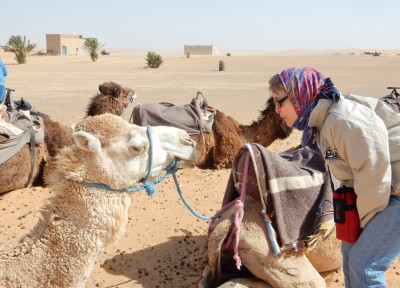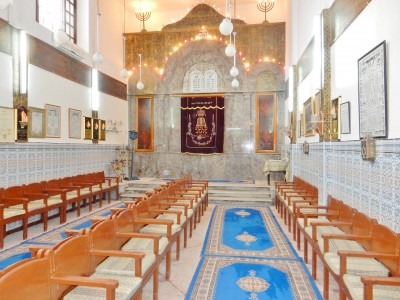A Volunteer Abroad

A blog post by volunteer Wendy Davis, JMM Docent. To read more posts by and about JMM volunteers click HERE.
My husband Bob just checked off one of the items on his bucket list – a trip to Morocco, a country in the northwest corner of Africa. Lucky me went with him. We had a fantastic time in Morocco seeing the various terrains from the fertile coastal plains, to the snow-capped mountains to the dunes of the Sahara. And the people we met were just as varied from college educated professionals to those with no formal education; western dressed to totally covered by jallaba and scarf; living in spacious multi-floor homes to a tent in the desert. And almost everywhere we went, we heard about the Jews who used to live there.

In every corner of Morocco, we heard about the Jews that moved there with the Muslims after expulsion from Spain in1492. But, we also learned that the majority of Jews left the country between the 1950s and 1970s. The various local guides we had all commented that the Jews wanted to move to Israel and that the Jews have always been welcome in Morocco. But, the ultimate truth is that the non–African Arab states were putting considerable pressure on the African countries to ostracize their Jews. In spite of the pressure, we were told that there has always been a Jewish advisor to the king, even today; and, it is very common for those that have moved away to return with their children for visits and to check on their property that is rented to others. We saw remnants of their lives sold in shops – yads, menorahs, mezuzahs, carved doors, traditional wedding rings, tefillin, jewelry, books, sections of Torah…. I found the sale of these objects and the fact that the Jews felt a need to leave an area that had been their home for hundreds of years very disturbing.

As we walked through the old Jewish quarters in the medinas (the walled cities) called mellahs we noticed streets with Jewish names. We noticed telltale scars of long gone mezuzahs on doorposts and the occasional plaque marking the location of a closed synagogue. Most of the remaining Moroccan Jews, just like the Baltimorean Jews, have moved out of the old cities into the newer sections of town. In the old mellah in Marrakesh, we did find an active synagogue that was established in 1492 according to the plaque on the wall. Unlike Baltimore’s B’nai Israel, there isn’t a renewal of younger congregants to replace those that are mostly elderly and are dying off.

Contrary to what I heard before our trip, my husband and I felt comfortable traveling openly as Jews. It was obvious by the new Judaica (mezuzahs, hanukiahs, kiddish cups) for sale in shops and the way we were treated by the local retail salesmen and others with whom we engaged in conversation, that Jewish tourists are welcome.
